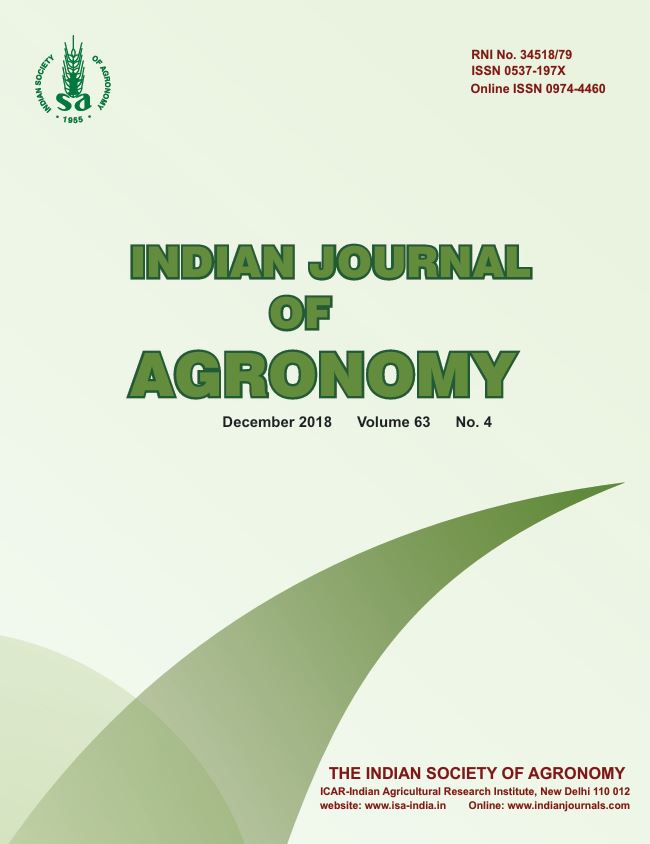Chemical weed management in wheat (Triticum aestivum) using ready-mix and tank-mix herbicides
DOI:
https://doi.org/10.59797/ija.v63i4.5679Keywords:
Economics, Growth, Herbicides, Wheat, YieldAbstract
A field experiment was conducted at the Bichpuri, Agra, Uttar Pradesh during the winter (rabi) seasons of 2011–12 and 2012–13, to evaluate the effect of different grass and broad-leaf herbicides as sole and ready-mix application on weed control in wheat (Triticum aestivum L.). Ready-mix application of herbicides proved better than their alone application in suppressing weed number and dry weight. Application of sulfosulfuron + metsulfuron (25 + 4 g/ha) resulted in the highest weed-control efficiency (WCE) as well as herbicide efficiency (HEI) and lowest weed index of 94.8%, 2.97 and 3.3 respectively. The highest grain and stover yield of 4.05 and 6.39 t/ha were obtained from weed-free treatment, although this remained statistically at par with sulfosulfuron + metsulfuron (25 + 4 g/ha) and both the treatments resulted in an increase of 34.6 and 30.2% in grain yield as compared to weedy check respectively. The highest net returns ( 43,200/ha) and benefit: cost ratio (2.40) were obtained with ready-mix application sulfosulfuron metsulfuron (25 + 4 g/ha) among the tested herbicide treatments.
References
Anjuman, T. and Bajwa, R. 2010. Competition losses caused by
Rumex dentatus L. and Chenopodium album L. in wheat
(Triticum aestivum L.). The Philippine Agricultural Scientist
(3): 110–115.
Bajya, D.R., Parveen, T., Lakharam, M.C. and Raja, S.K. 2015. Efefficacy of new formulations of trisulfuron on weeds in wheat
and their residual effects on succeeding maize. Indian Journal of Agronomy 60(1): 57–60.
Chauhan, T.M., Ali, J., Singh, H., Singh, N. and Singh, S.P. 2014.
Effect of zinc and magnesium nutrition on yield, quality and
removal of nutrients in wheat (Triticum aestivum L.). Indian
Journal of Agronomy 59(2): 276–280.
Chopra, N.K., Chopra, N. and Choudhary, D. 2015. Bioefficacy of
sole and tankmix of pinoxaden and clodinofop with
carfentazone and metsulfuron for control of complex weed
flora in wheat. Indian Journal of Agronomy 60(1): 104–108.
Dhawan, R., Punia S.S., Singh, S., Yadav, D. and Malik, R.K. 2009.
Productivity of wheat as affected by continuous use of new
low dose herbicides for management of little canary grass
(Phalaris minor). Indian Journal of Agronomy 54(1): 58–
Gomez, K.A. and Gomez, A.A. 1984. Statistical Procedures for
Agricultural Research, edn 2, John Willey & Sons, Inc.,
New York, the USA.
Jain, V., Jain, N. and Kewat, M.L. 2014. Effect of application of
post-emergence herbicides at different levels of available soil
moisture content in irrigated wheat. Indian Journal of
Agronomy 59(1): 91–95.
Kaur, T., Bhullar, M.S. and Walia, U.S. 2015. Bio-efficacy of ready
mix formulation of clodinafop-propargyl + metsulfuron for
control of mixed weed flora in wheat. Indian Journal of
Weed Science 47(2): 121–124.
Khan, N., Chaudhry, S., Siddiqui, M.Z., Yadav, R.A. and Husain, K.
Effect of weed management options and nitrogen
scheduling on weed dynamics and yield of wheat (Triticum
aestivum L.) under central plain zone of Uttar Pradesh. Indian Journal of Agronomy 62(4): 464–469.
Kumar, M. and Das, T.K. 2008. Integrated weed management for
system productivity and economics in soybean–wheat system. Indian Journal of Agronomy 53(3): 189–194.
Meena, B.L. and Singh, R.K. 2013. Response of wheat to rice and
weed management practices. Indian Journal of Agronomy
(4): 521–524.
Mehmood, Zia, Ashiq, Muhammad, Noorka, Ijaz Rasool, Ali,
Amjed, Tabasum, Saba and Iqbal, Muhammad Shahid.
Chemical control of monocot weeds in wheat (Triticum aestivum L.). American Journal of Plant Sciences 5(9):
pages DOI:10.4236/ajps.59140.
Pal, S., Sharma, R., Sharma, H.B. and Singh, R. 2016. Influence of
different herbicides on weed control, nutrient removal and
yield of wheat (Triticum aestivum L.). Indian Journal of
Agronomy 61(1): 59–63.
Tomar, S.K. and Tomar, T.S. 2014. Effect of herbicides and their
tank mixture on weed dynamics and yield of zero-tilled
wheat (Triticum aestivum L.) under rice (Oriza sativa L.)–
wheat cropping system of eastern Uttar Pradesh. Indian
Journal of Agronomy 59(4): 624–628.
Singh, A.P., Pandagare, T., Abrahum, S., Chandrakar, D. and
Chowdhury, T. 2015. Evaluation of metribuzin in combination with clodinafop, sulfosulfuron and Pinoxaden for weed
control in wheat. International Journal of Life Science
(1): 271–274.






